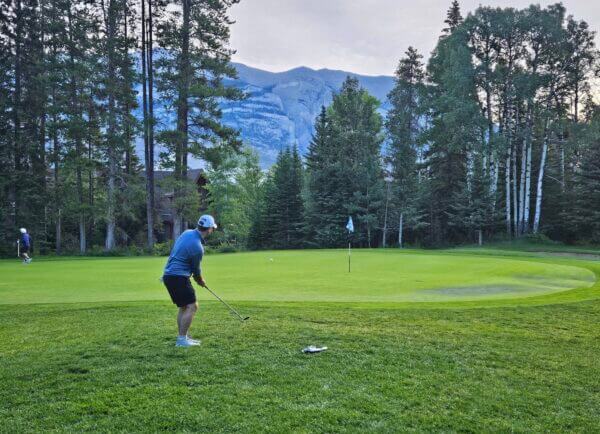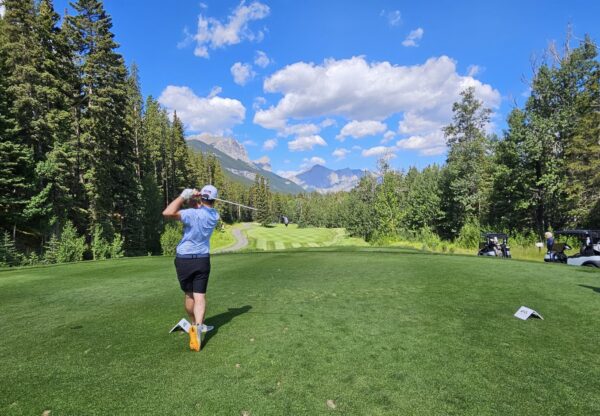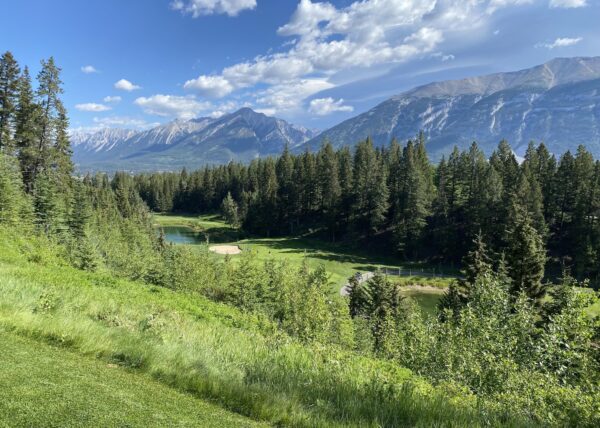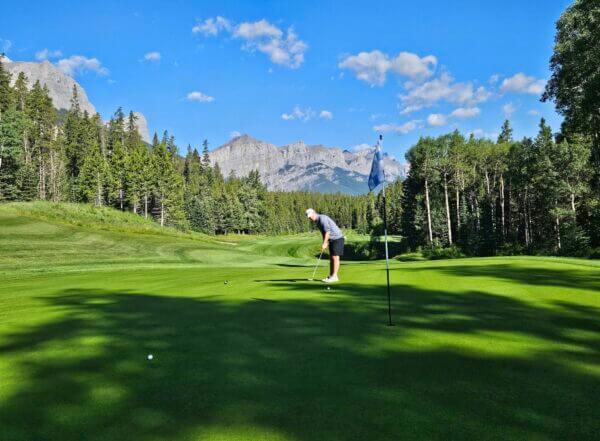Editor’s Note: I have no relationship with the course and paid full price to play. This is a fully transparent review of my experience.
There is an argument to be made that if you were to move Pebble Beach one mile inland, it would suddenly disappear from top course lists.
The Pacific Ocean is a defining character in the Pebble Beach story—but what if it wasn’t?
It’s a moot 19th-hole kind of discussion to deal in such hypotheticals. Pebble Beach is by the water, so what the hell are we talking about?
It does, however, bring up a conundrum I’ve found myself noodling over in recent years:
Is a course defined by playing areas only? Or is a course defined by its setting?
In other words, can course and surrounds be separated in evaluating a layout? Should they be?
Never have I felt such a push and pull with this question as when I played Stewart Creek Golf and Country Club in Canmore, Alberta, Canada.
A true mountain course with sublime views, Stewart Creek is Instagram ready.
But if you took away the mountains, what story does the course tell?
Like playing golf in heaven
Two months ago, my wife and I took a road trip from Vancouver to Calgary. Our 12-day adventure included whale watching, hiking, glacier tours, gondola rides and a lot more.
If you haven’t been to western Canada, I highly recommend the trip. The scenery is breathtaking at every turn. Of the 10 best hikes we’ve ever done, at least four of them were here.
We ended our vacation in Canmore, a small utopia of a town that is 20 minutes from Banff and a little over an hour from Calgary. This is where Stewart Creek is nestled up against the Three Sisters—a trio of mountain peaks that loom large over the course.
The Canadian Rockies are ever-present in nearly all directions. An endless sea of trees, cascading down in a wave, makes every fairway into an island. Miss the fairway and, with few exceptions, you don’t have to bother looking for your ball.
This is one of the only courses I’ve played where you are fully out in nature. While we didn’t see any wildlife during our round, a quick scan of Stewart Creek’s social media shows plenty of golfer encounters with bears, elk and other animals. A few miles from the course, within the same Bow Valley nature corridor where Stewart Creek resides, my wife and I saw a bear with two cubs.
It would be impossible to overstate the presence of this backdrop. Golf course beauty of this magnitude is rare. And seeing your ball fly (a little farther than normal because of the altitude) towards the gargantuan mountains in the distance is such a trippy, exhilarating feeling.
As beautiful as the pictures are, being there in person is a whole other experience.
Stewart Creek opened on June 1, 2000, and just celebrated its 25th anniversary. Of particular note, the course was designed by Gary Browning. Browning is a landscape architect with expertise in resort planning, master planning and landscape design. His degree is in environmental design.
This is all to say that Browning is not your traditional golf course architect because golf is just one element of his business. Talented guy.
A semi-private club with members-only play on weekend mornings, Stewart Creek is accommodating to the visiting public. All three of my playing partners were tourists.
At Stewart Creek, Browning neatly weaves ribbons of perfectly manicured fairways around the majestic mountains for a par-71 track that tips out at 7,009 yards. There are five par-3s, with two of them coming back-to-back to finish your opening nine.
This is a borderline top-30 course in all of Canada, according to The Score.
The sight of the criss-crossed mowing lines and lush rough contrasted with the rugged gray mountains protruding out of the dark green trees … it’s enough to make a golfer cry tears of joy.
The experience of playing Stewart Creek

With our trip being in the middle of tourist season, I booked my tee time several months in advance. That ended up being necessary given how packed the tee sheet looked.
The final tally was $246 Canadian, about $177 USD.
Heading off early in the morning, I checked in at the clubhouse (beautiful) and hit a few balls at the range. The practice facility, which features a concession stand a few steps from the range, is quite pretty.
There is no walking here. Carts only. Too much elevation change and there are long distances between holes. Add in the possibility of coming across wildlife without the ability to zip away in a cart and it makes sense why walking is strongly discouraged.
After a few practice putts, I headed up to the first tee where a friendly starter gave us instructions for the day. “Leave wildlife alone” was the most important tip.
The first hole is a strong taste of what you will find throughout the day. The tee box sits well above the fairway for a short par-4 that was merely a 3-wood and gap wedge for this 9-handicapper. The view is among the best you get the whole day.
A handful of other holes stood out.
No. 6 — Par-5, 553 Yards
After a straightforward tee shot, you have a decision to make on your second. You can either stay to the right and take the high road or push the ball towards the green on the lower fairway.
No. 7 — Par-4, 405 Yards
This might have been the coolest tee shot of the day. It’s a right-to-left dogleg begging for a draw. The entire mountain you’re up against is screaming at you to hit a draw. If you can, it’s just a short flip of a wedge to a green that is partially obscured by a boulder.
No. 9 — Par-3, 212 Yards
Certainly one of the most gorgeous views I’ve ever had on a golf course. It would be in contention for top five without a doubt. You are hitting a short iron severely downhill as the mountains watch.
No. 14 — Par-4, 294 Yards
This drivable par-4 is an easy layup if you want it. The gap to get the ball up near the green is narrow but, hey, you’re (probably) on vacation. Just like calories don’t count, lost golf balls don’t count.
No. 18 — Par-5, 530 Yards
Your round ends with an ultra-reachable par-5 that likely requires no more than a 6-iron down the hill for your second shot. It’s a daunting shot with a small lake sitting just left of the green.
The positive parts of my experience

Playing golf on the side of a mountain is a great vibe. The views, including the way the course is situated next to the mountains, lived up to the hype.
We were lucky to have nice weather, which adds to all the beauty that surrounds.
The course was in very good but not perfect shape. Tee boxes, fairways and bunkers were pretty solid, if not excellent. The greens (photo above) were a little beat up in areas but generally smooth—they were not fast at all, but I wouldn’t say they were slow.
There are so many spots on this course where you want to take a picture because of how handsome a hole looks.
Customer service gets an A+. Everyone I encountered was smiling and helpful.
Accommodations and convenience also receive a strong grade. The course is about 10 minutes from the heart of Canmore where our Airbnb was. For those flying into Calgary—which has direct flights to my hometown of Nashville and many other U.S. cities—the drive is simple.
The negative parts of my experience

I alluded to this in my intro, but Stewart Creek’s best attribute is its geography.
Take that away and you are looking at a well-manicured but fairly benign course that feels aggressively utilitarian in spots.
Without the dramatic elevation changes—which really only come into play on a few holes—there is not much character to the course. The setting is the character.
The greens are dead flat with nothing interesting happening around them. Most of the holes are interchangeable.
On top of that, it gets exhausting when you hit a tee shot offline and know your ball is toast. It’s basically like if every hole had OB on both sides of a 40-yard window. I like treelined courses, but I prefer when you can at least punch out back to the fairway.
Of course, the architect didn’t really have an option here. This course had to be carved out of dense woods. Wide-open fairways and using fun angles to create strategically captivating golf holes wasn’t the point of the project.
Regardless, this is not a design masterpiece by the purist’s standard. Not by a mile.
There is nothing deeper to uncover here. No tantalizing shots that have you desperate to race back to the first tee so you can try again.
We’ve all played those kinds of courses. This is not that. You pay your $180, you have a good time, you take your pictures and you likely never play it again.
The mountains make the course memorable—but also hold the course back because of space constraints.
Now is the time when you might be yelling at your screen: “But it’s a mountain course! You can’t take the mountains away!”
Therein lies the dilemma I’ve been wrestling with as I sat down to write this review.
The tourist in me loves Stewart Creek and thinks it’s an awesome place. The golfer in me knows that it’s a one-off, like how cooking a whole turkey is great for Thanksgiving dinner … but it doesn’t hit the same when you do it on a Tuesday in May.
The final verdict

If you are a golfer on vacation in the Canadian Rockies, Stewart Creek is a lovely place to play.
I’m told there are other good, possibly better, options in the area. That includes a few Stanley Thompson designs like Banff Springs and Jasper Park.
No matter, I have zero regrets about playing here. On the contrary, I’m satisfied with my experience.
Mountain golf is awesome just based on the views you have and the unique opportunity to hit golf shots with insane elevation changes.
For $177 USD, Stewart Creek is definitely worth playing once as a visitor.
You are here to play golf next to a mountain and get some awesome pictures. That is a reasonable value. I had a great time.
However, I would not play here a second time.
For that reason, my overall grade is two-pronged: Stewart Creek gets an A- for the first/only play and a C+ for day-in, day-out play.
There are very few courses that fit so squarely into this category, but I think Stewart Creek does.
Some of you reading this will play here and give it a much higher grade. I understand that. It’s a beautiful course in a beautiful place.
I haven’t played much golf in Canada but I’m going to assume there are 30 better courses. Canadians, am I right? I’ll get to some of those soon (anyone up for a trip to Cabot? Drinks are on me).
As for the ultimate question of whether you can separate a course from its surrounds, maybe the answer is like my grade—a little complicated.
Superficially, you can’t separate them. The mountains make Stewart Creek like the ocean makes Pebble.
But the deeper you want to dig, the more the true bones of a course are exposed. If you are like me, you want to be stimulated by the shots you are hitting more than just the intoxicating views.
Have you played Stewart Creek? Would you want to based on these photos and my review? Is mountain golf overrated?
Let me know below in the comments.
The post MGS Experiences: Stewart Creek appeared first on MyGolfSpy.
